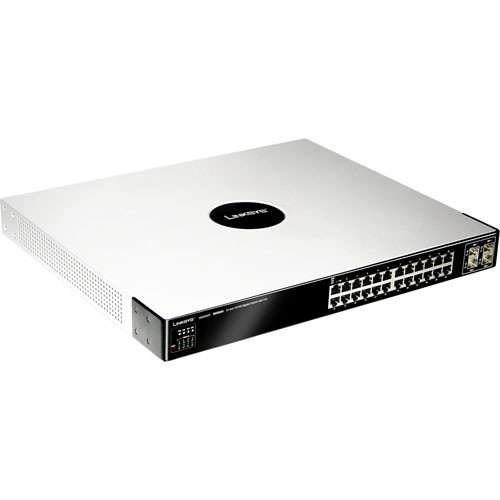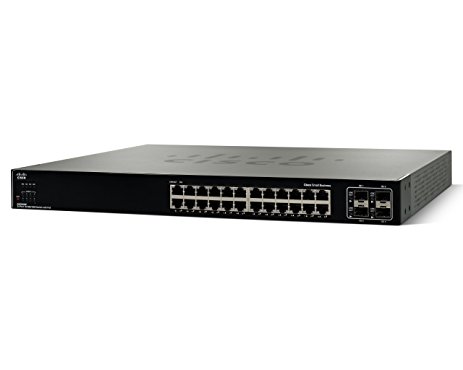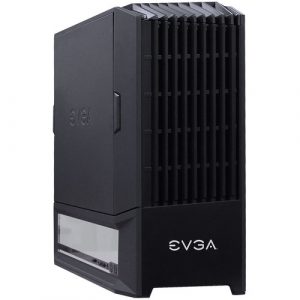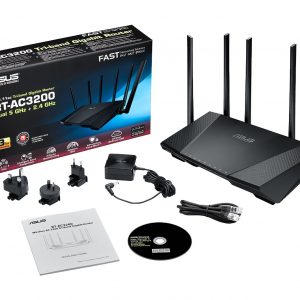Cisco SGE2000P 24-port Gigabit Switch with PoE
Highlights
● 24 high-speed ports optimized for the network core or to support bandwidth-intensive applications
● Resilient Clustering provides the ability to add more switches as needed and to manage the stack as a single switch, to support growing businesses
● Power over Ethernet easily and cost-effectively powers wireless access points, video cameras, and other network-connected endpoints
● Strong security protects network traffic to keep unauthorized users off the network
● Intelligent QoS helps ensure a consistent network experience and supports networked applications including voice, video, and data storage
Cisco Small Business SGE2000P 24-Port 10/100/1000 Gigabit Ethernet Switch with PoE, 4 Shared SFP Slots and Stacking
– Desktop (LJ3936) Category: Network Switches

High-Performance, Secure Switching with PoE for Small Businesses
Highlights
- 24 high-speed ports optimized for the network core or to support bandwidth-intensive applications
- Resilient Clustering provides the ability to add more switches as needed and to manage the stack as a single switch, to support growing businesses
- Power over Ethernet easily and cost-effectively powers wireless access points, video cameras, and other network-connected endpoints
- Strong security protects network traffic to keep unauthorized users off the network
- Intelligent QoS helps ensure a consistent network experience and supports networked applications including voice, video, and data storage
- Limited lifetime warranty
Figure 1. Cisco SGE2000P 24-Port Gigabit Switch: PoE
Product Overview
The Cisco® SGE2000P 24-Port Gigabit Switch (Figure 1) helps maximize system availability, with fully redundant stacking and dual images for resilient firmware upgrades. The switch helps secure the network through IEEE 802.1Q VLANs, IEEE 802.1X port authentication, access control lists (ACL), denial-of-service (DoS) prevention, and MAC-based filtering. The enhanced quality of service (QoS) and traffic-management features help ensure clear and reliable IP voice and video communications.
For wireless or voice over IP (VoIP) deployments, the Cisco SGE2000P supports the IEEE802.3af standard for Power over Ethernet (PoE). Automatic load sensing in the power control circuitry automatically detects PoE on the end device before providing power. For safety, each port has independent overload and short-circuit protection, along with LED indicators for power status. A maximum of 15.4W is available on the Fast Ethernet ports for powering PoE-enabled wireless access points or VoIP handsets, with a maximum per-device PoE delivery of 185W available for all ports.
The Cisco SGE2000P provides an intuitive, secure management interface, enabling network administrators to better utilize its comprehensive management feature set, for a better-optimized and more secure network.
Features
- Twenty-four 10/100/1000 Ethernet ports
- Four Small Form-Factor Pluggable (SFP) slots (shared with four copper ports) for fiber Gigabit Ethernet expansion
- IEEE 802.3af PoE delivered over any of the twenty-four 10/100/1000 copper ports
- Up to 15.4W available on the copper ports for powering PoE-enabled wireless access points or VoIP handsets, with a maximum per-device PoE delivery of 185W available for all ports
- Dual images for resilient firmware upgrades
- 48-Gbps, nonblocking, store-and-forward switching capacity
- Simplified QoS management using 802.1p, Differentiated Services (DiffServ), or type of service (ToS) traffic prioritization specifications
- Fully resilient stacking for optimized growth with simplified management
- ACLs for granular security and QoS implementation
- Can be configured and monitored from a standard web browser
- Secure remote management of the switch via Secure Shell (SSH) and SSL encryption
- 802.1Q-based VLANs enable segmentation of networks for improved performance and security
- Private VLAN Edge (PVE) for simplified network isolation of guest connections or autonomous networks
- Automatic configuration of VLANs across multiple switches through Generic VLAN Registration Protocol (GVRP) and Generic Attribute Registration Protocol (GARP)
- User/network port-level security via 802.1X authentication and MAC-based filtering
- Increased bandwidth and added link redundancy with Link Aggregation Control Protocol (LACP)
- Enhanced rate-limiting capabilities, including back pressure and multicast and broadcast flood control
- Port mirroring for noninvasive monitoring of switch traffic
- Jumbo frame support up to 10KB
- Simple Network Management Protocol (SNMP) versions 1, 2c, and 3 and Remote Monitoring (RMON) support
- Fully rack mountable using the included rack-mounting hardware
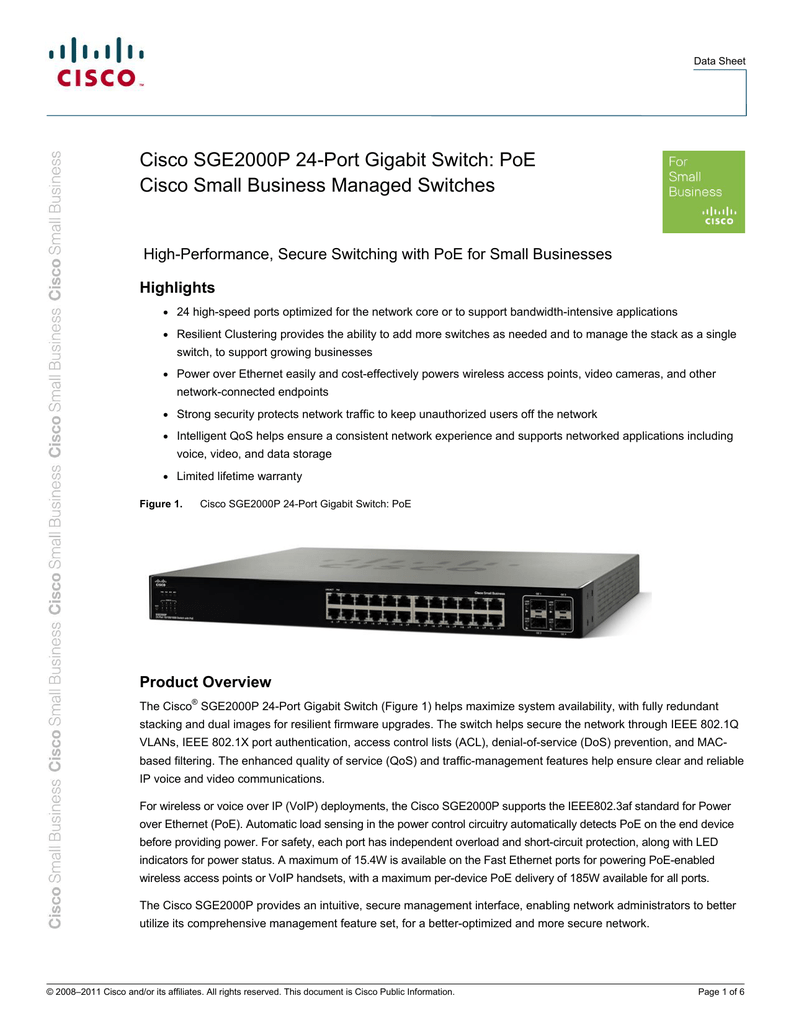
Specifications
| Feature | Description |
|
Specifications |
|
|
Ports |
● 24 RJ-45 connectors for 10BASE-T/100BASE-TX/1000BASE-T with 4 shared Gigabit SFP slots
● Console port ● Auto medium dependent interface (MDI) and MDI crossover (MDI-X) ● Auto negotiate/manual setting ● RPS port for connecting to redundant power supply unit |
|
Buttons |
Reset button |
|
Cabling type |
● Unshielded twisted pair (UTP) Category 5 or better for 10BASE-T/100BASE-TX
● UTP Category 5 Ethernet or better for 1000BASE-T |
|
LEDs |
PWR, Fan, Link/Act, PoE, Speed, RPS, Master, Stack ID 1 through 8 |
|
PoE |
|
| IEEE 802.3af PoE delivered over any of the twenty-four 10/100/1000 ports; power budget allows for max power of 15.4W on up to 12 ports simultaneously. | |
|
Performance |
|
|
Switching capacity |
Up to 48 Gbps, nonblocking |
|
Forwarding rate |
Up to 35.7 mpps |
|
Stacking |
|
|
Stack operation |
● Up to 8 units in a stack (192 ports)
● Hot insertion and removal ● Ring and chain stacking options ● Master and backup master for resilient stack control ● Auto-numbering or manual configuration of units in stack |
|
Layer 2 |
|
|
MAC table size |
8000 |
|
Number of VLANs |
256 active VLANs (4096 range) |
|
VLAN |
● Port-based and 802.1Q tag-based VLANs
● Protocol-based VLAN ● Management VLAN ● PVE ● GVRP |
|
Head-of-line (HOL) blocking |
HOL blocking prevention |
|
Layer 3 |
|
|
Layer 3 options |
● Static routing
● CIDR (classless interdomain routing) ● 128 static routes ● IPv4 ● Forwarding in silicon – wire-speed forwarding of Layer 3 traffic |
|
IPv6 |
|
|
IPv6 |
IPv6 Host Mode
IPv6 over Ethernet Dual IPv6/IPv4 stack IPv6 Neighbor and Router Discovery (ND) IPv6 Stateless Address Autoconfiguration Path MTU Discovery Duplicate Address Detection (DAD) ICMPv6 IPv6 over IPv4 network with ISATAP tunnel support |
|
IPv6 QoS |
Prioritize IPv6 packets in hardware |
|
IPv6 ACL |
Drop or Rate Limit IPv6 packets in hardware |
|
MLD Snooping |
Deliver IPv6 multicast packets only to the required receivers |
|
IPv6 Applications |
Web/SSL, Telnet Server/SSH, Ping, Traceroute, SNTP, TFTP, Radius, Syslog, DNS Client |
|
IPv6 RFCs Supported |
RFC2463 – ICMPv6
RFC3513 – IPv6 Address architecture RFC 4291 – IP Version 6 Addressing Architecture RFC 2460 – Internet Protocol v6 (IPv6) Specification RFC 2461 – Neighbor Discovery for IPv6 RFC 2462 – IPv6 Stateless Address Auto-configuration RFC 1981 – Path MTU Discovery RFC 4007 – IPv6 Scoped Address Architecture RFC3484 – Default address selection mechanism is described by RFC3484 RFC4214 – ISATAP tunneling RFC4293 – MIB IPv6: Textual Conventions and General Group RFC 3595 – Textual Conventions for IPv6 Flow Label |
|
Management |
|
|
Web user interface |
Built-in web user interface for easy browser-based configuration (HTTP/HTTPS) |
|
SNMP |
SNMP versions 1, 2c, and 3 with support for traps |
|
SNMP MIBs |
RFC1213 MIB-2, RFC2863 interface MIB, RFC2665 Ether-like MIB, RFC1493 bridge MIB, RFC2674 extended bridge MIB (P-bridge, Q-bridge), RFC2819 RMON MIB (groups 1, 2, 3, and 9 only), RFC2737 entity MIB, RFC3621 Power Ethernet MIB, RFC 2618 RADIUS client MIB, RFC1215 traps |
|
RMON |
Embedded RMON software agent supports 4 RMON groups (history, statistics, alarms, and events) for enhanced traffic management, monitoring, and analysis. |
|
Firmware upgrade |
● Web browser upgrade (HTTP) and Trivial File Transfer Protocol (TFTP)
● Dual images for resilient firmware upgrades |
|
Port mirroring |
Traffic on a port can be mirrored to another port for analysis with a network analyzer or RMON probe |
|
Other management |
● Traceroute
● Single IP management ● SSL security for web user interface ● SSH ● RADIUS ● Port mirroring ● TFTP upgrade ● Dynamic Host Configuration Protocol (DHCP) client ● BOOTP ● Simple Network Management Protocol (SNTP) ● Xmodem upgrade ● Cable diagnostics ● Ping ● Syslog ● Telnet client (SSH secure support) |
|
Security |
|
|
IEEE 802.1X |
● 802.1X – RADIUS authentication; MD5 hash
● Guest VLAN ● Single/multiple host mode |
|
Access control |
ACLs – drop or rate limit based on:
● Source and destination MAC-based ● Source and destination IP address ● Protocol ● Port ● VLAN ● Differentiated services code point (DSCP)/IP precedence ● TCP/ User Datagram Protocol (UDP) source and destination ports ● 802.1p priority ● Ethernet type ● Internet Control Message Protocol (ICMP) packets ● Internet Group Management Protocol (IGMP) packets ● Up to 1018 rules |
|
Availability |
|
|
Link aggregation |
● Link aggregation using IEEE 802.3ad LACP
● Up to 8 ports in up to 8 groups |
|
Storm control |
Broadcast and multicast storm protection |
|
DoS prevention |
DoS attack prevention |
|
Spanning Tree |
● IEEE 802.1D Spanning Tree
● IEEE 802.1w Rapid Spanning Tree ● IEEE 802.1s Multiple Spanning Tree, Fast Linkover |
|
IGMP snooping |
IGMP (versions 1 and 2) snooping limits bandwidth-intensive video traffic to only the requestors. Supports 256 multicast groups. |
|
QoS |
|
|
Priority levels |
4 hardware queues |
|
Scheduling |
Priority queuing and weighted round-robin (WRR) |
|
Class of service |
● Port based
● 802.1p VLAN priority based ● IPv4 IP precedence/ToS/DSCP based ● DiffServ ● Classification and re-marking ACLs |
|
Rate limiting |
● Ingress policer
● Egress rate control |
|
Standards |
802.3 10BASE-T Ethernet, 802.3u 100BASE-TX Fast Ethernet, 802.3ab 1000BASE-T Gigabit Ethernet, 802.3z Gigabit Ethernet, 802.3x flow control, 802.3ad LACP, 802.3af POE, 802.1d Spanning Tree Protocol (STP), 802.1Q/p VLAN, 802.1w Rapid STP, 802.1s Multiple STP, 802.1X port access authentication |
|
Environmental |
|
|
Dimensions |
17.32 x 14.70 x 1.73 in. (440 x 375 x 44 mm) |
|
Unit weight |
15.85 lb (7.19 kg) |
|
Certification |
UL (UL 60950), CSA (CSA 22.2), CE Mark, FCC Part 15 (CFR 47) Class A |
|
Operating temperature |
32º to 104ºF (0º to 40ºC) |
|
Storage temperature |
–4º to 158ºF (–20º to 70ºC) |
|
Operating humidity |
10% to 90% relative humidity, noncondensing |
|
Storage humidity |
10% to 95% relative humidity, noncondensing |
|
Number of fans |
5 |
|
Acoustic noise |
55 dB Max. |
|
Power |
100–240V AC, 50–60 Hz, internal, universal; also equipped with redundant power supply connector for external power supply, 48V DC |
|
Power consumption |
● No PoE supplied: 12V at 8.5A (102W)
● 12 ports half power (7.5W):192W ● 12 ports full power (15W): 282W ● 24 ports half power (7.5W): 282W |
|
Package Contents |
|
| ● Cisco SGE2000P 24-Port Gigabit Switch
● Console cable ● AC power cord ● Rack-mount kit ● Quick installation guide |
|
|
Minimum Requirements |
|
| ● Web browser: Mozilla Firefox 1.5 or later, Internet Explorer 5.5 or later, Netscape 7.01 or later
● Category 5 Ethernet network cable ● TCP/IP protocol installed on each computer within the network ● Network adapter installed in each computer ● Network operating system |
|
|
Product Warranty |
|
| Limited lifetime warranty with return to factory replacement, one year telephone support and software fixes for the warranty term. | |
Voice VLAN implementation on SGE2000P

Accessing the device through console port
Step 1. Connect the switch to the computer through console port.
Step 2. Open Hyper Terminal on your computer.

Note: You will need to use third party Hyper Terminal software for Windows Vista because this software is not available anymore on this version.
Step 3. You can use any name and then choose the communication port you are using on the back of the computer.

Step 4. Set the serial port settings as follows
•Bits per second: 115200
•Data bits: 8
•Parity: None
•Stop bits: 1
•Flow control: None

Step 5. On the login screen type admin for the username and leave the password blank.

Step 6. Go to the System Mode tab for the device. By default the switch is set to Layer 3. You will need to set it to Layer 2 so you can use static IP address for the device.


Step 7. Save the settings and then go back to the System Configuration tab.

Step 8. Go to the IP address settings and then set the device to static IP address. After assigning the static IP address for the switch, save the settings.


Step 9. You may access the setup page for the switch now using your web browser. On your browser type http://192.168.1.254 and it will ask for the username and password. The default username is admin and leave the password blank.

Note: If you are using DHCP address for the switch, you may still be able to access the device through your browser. You will need to check the DHCP address assigned for the device from your DHCP server.
Service & Support
Cisco Small Business switches are backed by the Cisco Small Business Support Service, which provides affordable peace-of-mind coverage. This subscription-based service helps you protect your investment and derive maximum value from Cisco Small Business products. Delivered by Cisco and backed by your trusted partner, this comprehensive service includes software updates, access to the Cisco Small Business Support Center, and expedited hardware replacement.
Cisco Small Business products are supported by professionals in Cisco Small Business Support Center locations worldwide who are specifically trained to understand your needs. The Cisco Small Business Support Community, an online forum, enables you to collaborate with your peers and reach Cisco technical experts for support information.
Cisco Limited Lifetime Hardware Warranty
This Cisco Small Business product offers a limited lifetime hardware warranty with return to factory replacement and a 1-year limited warranty for fans and power supplies. In addition, Cisco offers telephone technical support at no charge for the first 12 months following the date of purchase and software bug fixes for the warranty term. To download software updates, go to: http://www.cisco.com/cisco/web/download/index.html.
Product warranty terms and other information applicable to Cisco products are available at http://www.cisco.com/go/warranty.
For More Information
For more information on Cisco Small Business products and solutions, visit: http://www.cisco.com/smallbusiness.
How To Buy


